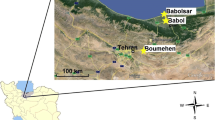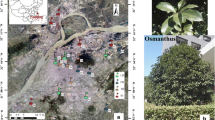Abstract
The magnetic properties of tree leaves along with their ecological, economical and aesthetic importance can be used to control road derived respirable particulates. Isothermal remanent magnetization (IRM300 mT) of three different tree leaves viz. Mango (Mangifera indica), Sisso (Dalbergia sisso) and Banyan (Ficus benghalensis) were determined and IRM300 mT normalized for the leaf area. The normalized 2-D magnetization of leaves as shown by results is dominantly controlled by leaf morphology and traffic density. F. benghalensis (Banyan) leaf has highest 2-D magnetization and D. sisso (Sisso) leaf having least 2-D magnetization suggesting greater ability of F. benghalensis (Banyan) tree leaves to reduce magnetic particulates. The particle size of the magnetic grains falls in the category of PM2.5, a particle size hazardous to human health due to its capacity to be inhaled deeply into the lungs.
Similar content being viewed by others
References
Alfani, A., Baldantoni, D., Maisto, G., Bartoli, G., & Virzo de Santo, A. (2000). Temporal and spatial variation in C, N, S and trace element contents in the leaves of Quercus ilex within the urban area of Naples. Environmental Pollution, 109, 119–129.
Flanders, P. J. (1994). Collection, measurement, and analysis of airborne magnetic particulates from pollution in the environment. Journal of Applied Physics, 75, 5931–5936.
Freer-Smith, P. H., Holloway, S., & Goodman, A. (1997). The uptake of particulates by an urban woodland, site description and particulate composition. Environmental Pollution, 95(1), 27–35.
Gautam, P., Blaha, U., & Appel, E. (2005). Magnetic susceptibility of dust-loaded leaves as a proxy of traffic-related heavy metal pollution in Kathmandu city, Nepal. Atmospheric Environment, 39, 2201–2211.
Georgeaud, V. M., Rochette, P., Ambrosi, J. P., Vandamme, D., & Williamson, D. (1997). Relationship between heavy metals and magnetic properties in a large polluted catchments, the Etang de Berre (South France). Physics and Chemistry of the Earth, 22(1–2), 211–214.
Hanesch, M., Scholger, R., & Dekkers, M. J. (2001). The application of fuzzy c-means cluster analysis and non-linear mapping to a soil data set for the detection of polluted sites. Physics and Chemistry of the Earth, 26(11–12), 885–891.
Hanesch, M., Scholger, R., & Rey, D. (2003). Mapping dust distribution around an industrial site by measuring magnetic parameters of tree leaves. Atmospheric Environment, 37, 5125–5133.
Harrison, R. M., & Yin, J. (2000). Particulate matter in the atmosphere: Which particle properties are important for its effects on health. The Science of the Total Environment, 249, 85–101.
Hay, K. L., Dearing, J. A., Baban, S. M. J., & Loveland, P. (1997). A preliminary attempt to identify atmospherically derived pollution particles in English topsoils from magnetic susceptibility measurements. Physics and Chemistry of the Earth, 22(1–2), 207–210.
Heider, F., Zitzelsberger, A., & Fabian, K. (1996). Magnetic susceptibility and remanent coercive force in grown magnetic crystals from 0.1 μm to 6 mm. Physics and Earth Planet International, 93, 239–256.
Hoffmann, V., Knab, M., & Appel, E. (1999). Magnetic susceptibility mapping of roadside pollution. Journal of Geochemical Exploration, 66, 313–326.
Hunt, A., Jones, J., & Oldfield, F. (1984). Magnetic measurements and heavy metals in atmospheric particulates of anthropogenic origin. Science of the Total Environment, 33, 129–139.
Impens, R. A., & Delcarte, E. (1979). Survey of urban trees in Brussels Belgium. Journal of Arboriculture, 5, 169–176.
Jordanova, N., Jordanova, D., Veneva, L., Yorova, K., & Petrovsky, E. (2003). Magnetic response of soils and vegetation to heavy metal pollution – A case study. Environmental Science and Technology, 37, 4417–4424.
Leocoanet, H., Leveque, F., & Ambrosi, J.-P. (2001). Magnetic properties of salt-marsh soils contaminated by iron industry emissions (Southeast France). Journal of Applied Geophysics, 48, 67–81.
Matzka, J., & Maher, B. A. (1999). Magnetic biomonitoring of roadside tree leaves, identification of spatial and temporal variations in vehicle-derived particulates. Atmospheric Environment, 33, 4565–4569.
Moreno, E., Sagnotti, L., Dinares-Turell, J., Winkler, A., & Cascella, A. (2003). Biomonitoring of traffic air pollution in Rome using magnetic properties of tree leaves. Atmospheric Environment, 37, 2967–2977.
Morris, W. A., Versteeg, J. K., Bryant, D. W., Legzdins, A. E., McCarry, B. E., & Marvin, X. H. (1995). Preliminary comparisons between mutagenic and magnetic susceptibility of respirable airborne particle. Atmospheric Environment, 29, 3441–3450.
Muxworthy, A., Matzka, J., & Petersen, N. (2001). Comparison of magnetic parameters of urban atmospheric particulate matter with pollution and meteorological data. Atmospheric Environment, 35, 4379–4386.
Muxworthy, A., Schmidbauer, E., & Petersen, N. (2002). Magnetic properties and Mossbauer spectra of urban atmospheric particulate matter, a case study from Munich, Germany. Geophysical Journal International, 150, 558–570.
Olson, K. W., & Skogerboe, R. K. (1975). Identification of soil lead compounds from automotive sources. Environmental Science and Technology, 9, 227–230.
Pope, III, C. A., Burnett, R. T., Thun, M. J., Calle, E. E., Krewski, D., Ito, K., et al. (2002). Lung cancer, cardiopulmonary mortality, and long-term exposure to fine particulate air pollution. Journal of the American Medical Association, 287, 1132–1141.
Prajapati, S. K., Pandey, S. K., & Tripathi, B. D. (2006). Monitoring of vehicles derived particulates using magnetic properties of leaves. Environmental Monitoring and Assessment. doi:10.1007/s10661-005-9055-y
Shu, J., Dearing, J. A., Morse, A. P., Yu, L., & Yuan, N. (2001). Determining the sources of atmospheric particles in Shanghai, China, from magnetic and geochemical properties. Atmospheric Environment, 35, 2615–2625.
Urbat, M., Lehndorff, E., & Schwark, L. (2004). Biomonitoring of air quality in the Cologne conurbation using pine needles as a passive sampler – Part I: Magnetic properties. Atmospheric Environment, 38, 3781–3792.
USEPA (2004). Air quality criteria for particulate matter. Research Triangle Park, NC, USA, October.
WHO (2003). Health aspects of air pollution with particulate matter, ozone and nitrogen dioxide. World Health Organisation, pp. 1–94.
Wichmann, H. E., & Peters, A. (2000). Epidemiological evidence of the effects of ultra fine particle exposure. Philosophical Transactions of the Royal Society of London, A358, 2751–2769.
Xie, S., Dearing, J. A., Boyle, J. F., Bloemendal, J., & Morse, A. P. (2001). Association between magnetic properties and element concentrations of Liverpool street dust and its implications. Journal of Applied Geophysics, 48, 83–92.
Author information
Authors and Affiliations
Corresponding author
Rights and permissions
About this article
Cite this article
Prajapati, S.K., Tripathi, B.D. Management of hazardous road derived respirable particulates using magnetic properties of tree leaves. Environ Monit Assess 139, 351–354 (2008). https://doi.org/10.1007/s10661-007-9841-9
Received:
Accepted:
Published:
Issue Date:
DOI: https://doi.org/10.1007/s10661-007-9841-9




